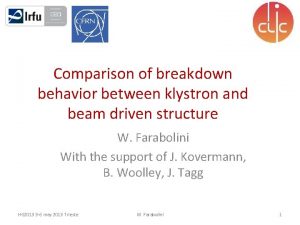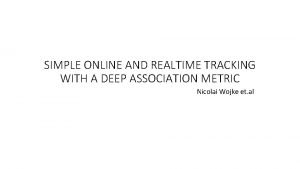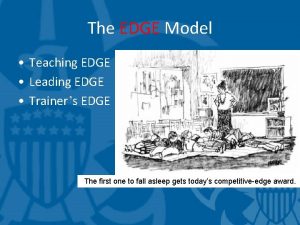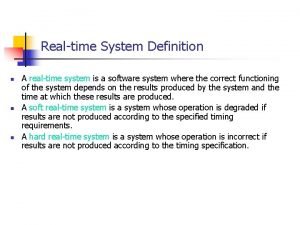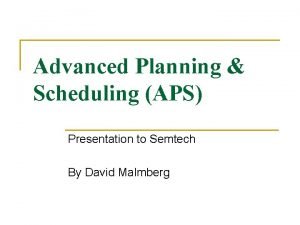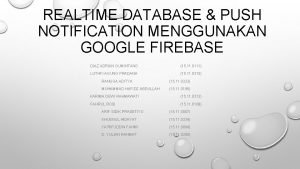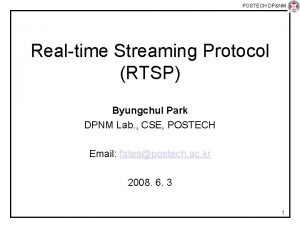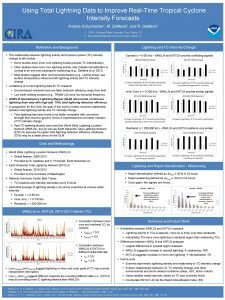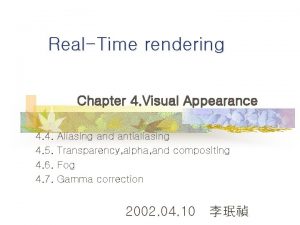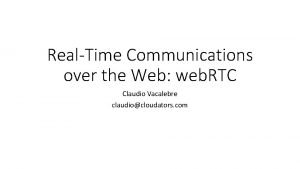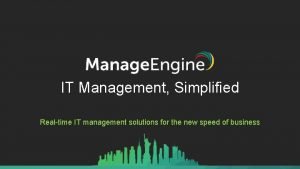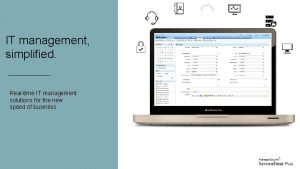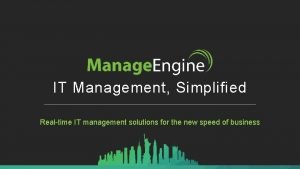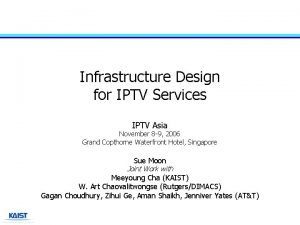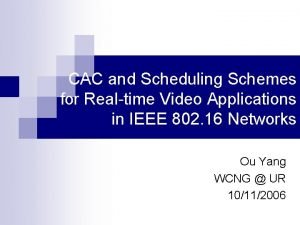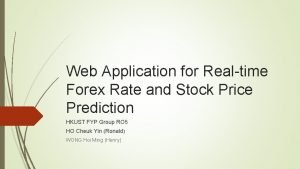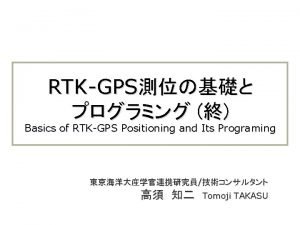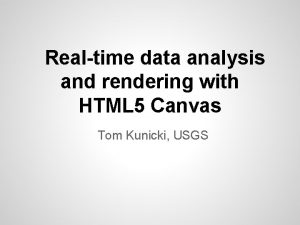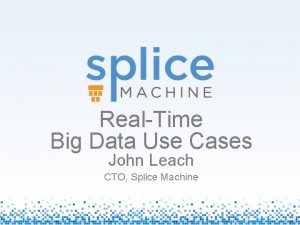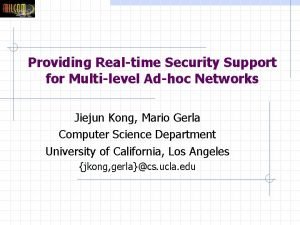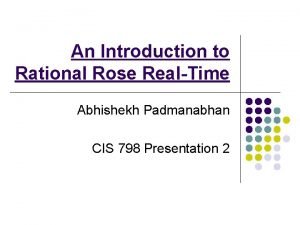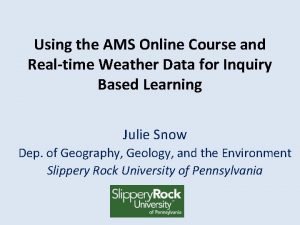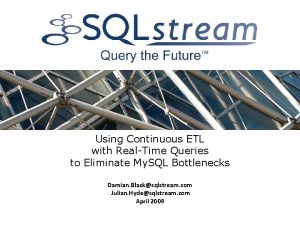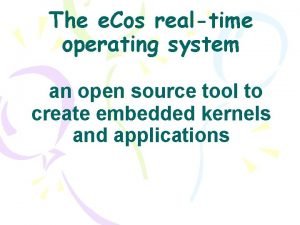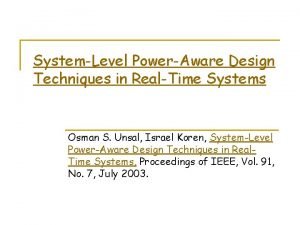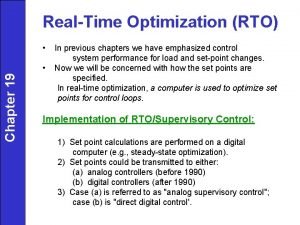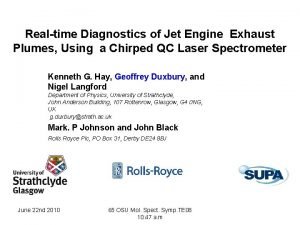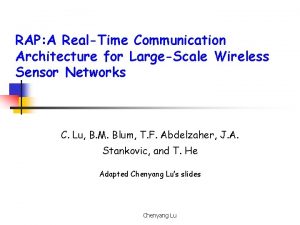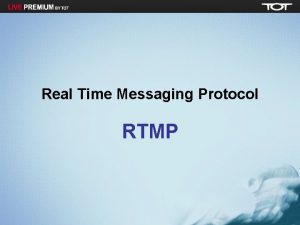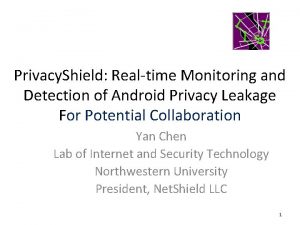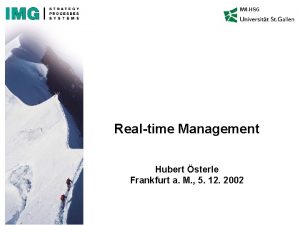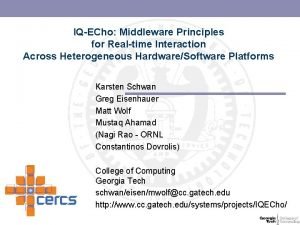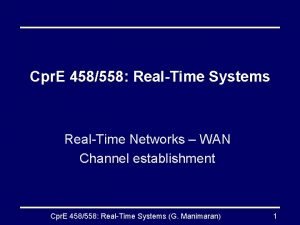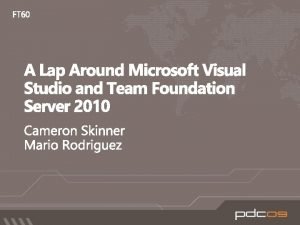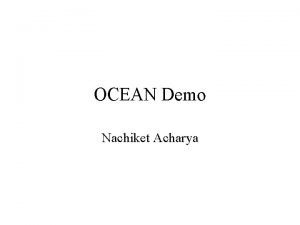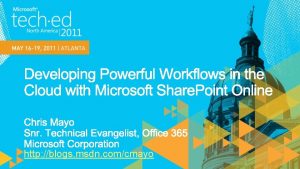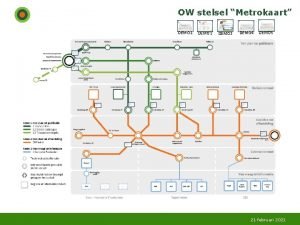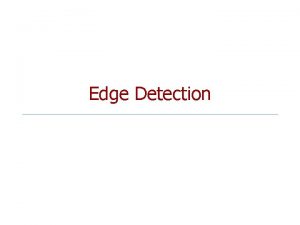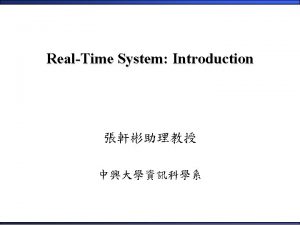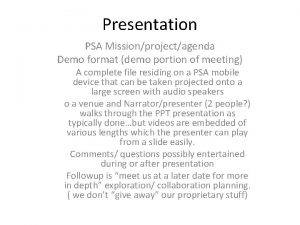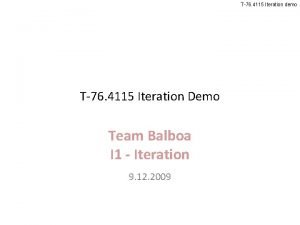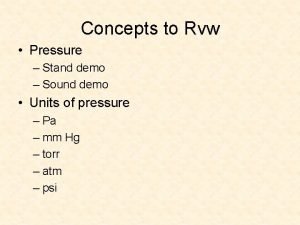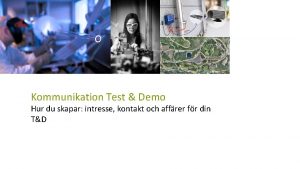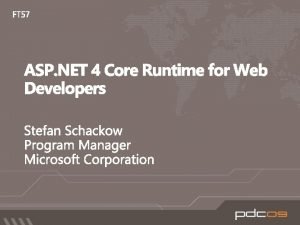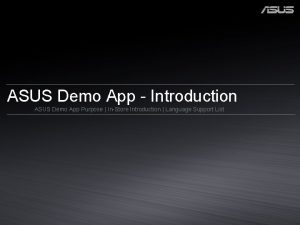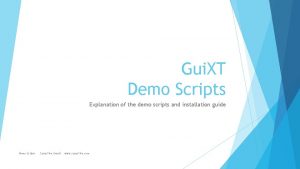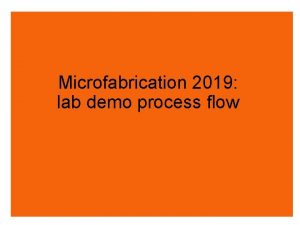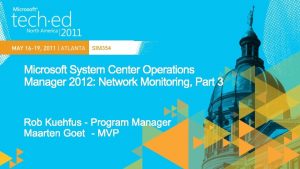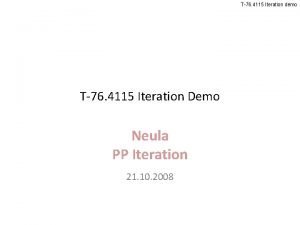A Presentation and a Demo on Realtime Edge






































- Slides: 38

A Presentation and a Demo on Real-time Edge Analytics By Pethuru Raj Chelliah Senthil Arunachalam Vidya Hungud Site Reliability Engineering (SRE) Reliance Jio Infocomm Ltd, Bangalore Confidential | 28 -07 -2017| version #

The Session Agenda 1. Setting the Context for the Session 2. The Edge / Fog Computing: What, Why, How and Where 3. The Practical Demonstration of a few Edge Applications 4. The Research Activities in the Fog / Edge Computing Space Confidential | DD. MM. YY | version #

Accelerating Digital Transformation through Connectivity + Cognition Digitization - Digitization in massive scale through the edge technologies (actuators, beacons, chips, codes, controllers, LEDs, sensors, specks, stickers, tags, etc. ) That is, every common thing in our midst becomes digitized entities/smart objects/sentient materials that are capable of contributing for mainstream computing Connectivity - Embedded systems are networked to communicate, collaborate, correlate and corroborate with one another. Device-to-device (D 2 D) and device-to-cloud (D 2 C) integration thrive towards sophisticated applications with the maturity of the Internet of Things (Io. T) technologies and cyber physical systems (CPSs) Service-enablement – Service-enabling the digitized and connected entities leads to the realization of scores of digital and device services Data Virtualization – When billions of different and distributed services interact, massive and multi-structed data gets produced and has to be collected and cleansed. Context information has to be embedded with digital data. Digital Intelligence by Cognition - Applying big, fast, and streaming analytics on digital data systematically is to create predictive, prognostic, prescriptive, and personalized insights, which can be looped back to people and systems to take timely decisions and to plunge into actions with all the clarity, confidence and correctness Digitization (Io. T) + Digital Intelligence (Io. T Data Analytics / Machine Learning) paves the way for digitally empowered and transformed enterprises Confidential | DD. MM. YY | version #

The Digital Transform Confidential | DD. MM. YY | version #

How to make Io. T Environments Intelligent? Any Io. T environment comprises scores of networked, resource-constrained and intensive, and embedded systems (digital objects, connected devices, and virtualized / containerized infra). Io. T artifacts are not individually intelligent. The charter is to make them intelligent individually as well as collectively 1. The Internet of Agents (Io. A) for empowering each digital object to be adaptive, articulate, reactive, and cognitive through mapping an software agent for each of the participating digital objects 2. The concept of Digital Twin / virtual object is also maturing and stabilizing 3. The proven and potential Io. T data analytics at edge and cloud levels is the prominent and dominant aspect for knowledge discovery and dissemination 4. The application of artificial intelligence (AI) technologies (machine and deep learning algorithms, computer vision, natural language processing, video processing, etc. ) leads to the realization of smarter systems, services and solutions 5. The new concept of smart contracts being popularized through the blockbuster blockchain technology leads to sophisticated and decentralized applications Confidential | DD. MM. YY | version #

Data Analytics towards Sophisticated Io. T Environments Confidential | DD. MM. YY | version #

Why Io. T Data Analytics? 1. Establishes a variety of smarter environments (smarter homes, hotels, hospitals, etc. ) 2. Uncovers timely and actionable insights for machines and men 3. Enables the realization of smart objects, devices, networks and environments, 4. Leads to the production of pioneering and people-centric applications and services 5. Helps to come out with precise predictions and prescriptions, 6. Facilitates process excellence and people productivity 7. Guarantees preventive maintenance of infrastructures 8. Ensures the optimized utilization of distributed assets through monitoring, measurement, and management for perfect inventory replenishment 9. Safeguards the safety and security of people and properties 10. Monitors complex environments to guarantee business performance, productivity and resilience Confidential | DD. MM. YY | version #

Data Analytics at public Clouds for Smarter Homes 8

Why Io. T Data Analytics on Clouds? • Agility & Affordability - No capital investment of large-size infrastructures for analytical workloads. Just use and pay. Quickly provisioned and decommissioned once the need goes down. • Data Analytics Platforms in Clouds – Therefore leveraging cloud-enabled and ready platforms (generic or specific, open or commercialgrade, etc. ) are fast and easy • No. SQL & New. SQL Databases and Data Warehouses in Clouds – All kinds of database management systems and data warehouses in cloud speed up the process of next-generation data analytics. Database as a service (Daa. S), data warehouse as a service (DWaa. S), business process as a service (BPaa. S) and other advancements lead to the rapid realization of analytics as a service (Aaa. S). • WAN Optimization Technologies - There are WAN optimization products for quickly transmitting large quantities of data over the Internet infrastructure • Social and professional networking sites are running in public cloud environments • Enterprise-class Applications in Clouds – All kinds of customer-facing applications are cloud-enabled and deployed in highly optimized and organized cloud environments • Anytime, anywhere, any network and any device information and service access is being activated through cloud-based deployment and delivery • Cloud Integrators, Brokers & Orchestrators – There are products and platforms for seamless interoperability among geographically distributed cloud environments. There are collaborative efforts towards federated clouds and the Intercloud. • Sensor/Device-to-Cloud Integration Frameworks are available to transmit ground-level data to cloud storages and processing. 9

The Distinct Capabilities of Io. T Data Analytics Platforms 1. Scalability 2. Faster Data Ingestion 3. Better Read and Write Performance 4. Faster Query Processing 5. Flexibility and Portability (to run in edge, private and public clouds) 6. Distributed Processing through automated Sharding 7. Better Data Compression 8. Integrated and End-to-end Platform for all kinds of data and analytics 9. Machine and Deep Learning Capabilities 10. RESTful Interfaces 11. In-Memory & In-Database Analytics 10

IBM

The Device Categories IBM

Why Off-premise Cloud is not suitable for certain Io. T Data Analytics? 1. Cloud is centralized, federated, consolidated, shared, automated, compartmentalized, and programmable Infrastructure 2. Latency and Response time is often a critical part, especially when you deal with human life or emergency procedure. 3. Bandwidth Cost and Capacity is very often underestimated. If you want to use N smart devices requiring each one to communicate M bytes of data then you can quickly reach huge bandwidth requirements reaching Mbit/s or even Gbit/s at a gateway level. 4. Security and Privacy - transmitting device data over any open and public network is risky 5. Power consumption - Cloud computing is energy-hungry and that it is a concern for a low-carbon economy. 6. Data obesity – In a traditional cloud approach, huge amount of untreated data are pumped blindly into the cloud that it is supposed to have magical algorithms written by data scientists. This vision is really not the best efficient and it is much more wise to pre-treat data at a local level and to limit the cloud processes at the strict minimum. 7. Offline usages versus only-online usages – Pure cloud services do not allow offline usages. It is a major shortcoming since smart cities and industry 4. 0 applications require a dual offline/online paradigm. Confidential | DD. MM. YY | version #

Why Io. T Data Analytics has to be real-time and at Edge? • Volume and Velocity – ingesting, processing and storing such huge amounts of data which is gathered in realtime. • Security – devices can be located in sensitive environments, control vital systems or send private data. With the number of devices and the fact they are not humans who can simply type a password, new paradigms and strict authentication and access control must be implemented. • Bandwidth – if devices constantly send the sensor and video data, it will hog the internet and cost a fortune. Therefore edge analytics approaches must be deployed to achieve scale and lower response time. • Real-time Data Capture, Storage, Processing, Analytics, Knowledge Discovery, Decision-making and Actuation • Less Latency and Faster Response • Context-Awareness capability • Combining real-time data with historical state – there analytics solutions which handle batch quite well and some tools that can process streams without historical context. It is quite challenging to analyze streams and combine them with historical data in real-time.

The Edge Analytics: the brewing Options There are two major approaches for Io. T Edge Analytics 1. The first one is to have a special appliance embedded with Io. T Edge analytics platforms and SDKs and keep it or clusters of the appliance in a corner of the environment 2. The second option is to form an ad hoc edge device cloud by combining the resource-intensive devices in the environment to deploy Io. T data analytics platform to capture, stock and process digital data in real-time and at scale. 3. Even participating devices could have been stuffed with edge analytics software to be intelligent in their offerings, operations and outputs Io. T Edge Data Analytics Appliances & Platforms 1. 2. 3. 4. 5. 6. 7. Dell Edge Gateways for Io. T HPE Edgeline Io. T Systems IBM Watson at the Edge (Cognitive Edge Analytics) AXON – the Io. T Platform GE Predix Platform Fog. Horn The Azure Io. T Gateway SDK

The Device Clouds for Edge Analytics The edge cloud is to club together multiple and heterogeneous devices such as set-top boxes, gateways, microcontrollers, and other reasonably powerful devices in the vicinity to form an adhoc device cloud to procure and process all kinds of sensor and Io. T data. There are primarily two platforms such as OSGi-based Kura from Eclipse and Apache Edgent 1. Everyware Cloud (EC) 2. There are several custom implementations

The Edge Analytics Platform Features 1. Ingestion of device event or video streams 2. Manage device configuration and properties in a flexible schema 3. Automatically aggregate and query time series of sensor data 4. Maintain durable message queues per device for commands and actions 5. Enrich real-time of streaming data with context tables and historical data on the fly 6. Accelerate various real-time analytics queries 7. Notify real-time event processing services in case of detected changes/anomalies

The Industry Use Cases of Fog/Edge Computing IBM

The Io. T Edge Data Analytics Use Cases Manufacturing - From creating semiconductors to the assembly of giant industrial machines, edge intelligence enhances manufacturing yields and efficiency using real-time monitoring and diagnostics, machine learning, and operations optimization. The immediacy of edge intelligence enables automated feedback loops in the manufacturing process as well as predictive maintenance for maximizing the uptime and lifespan of equipment and assembly lines. Oil and gas extraction are high-stakes technology-driven operations that depend on real-time onsite intelligence to provide proactive monitoring and protection against equipment failure and environmental damage. Because these operations are very remote and lack reliable high speed access to centralized data centers, edge intelligence provides onsite delivery of advanced analytics and enables real-time responses required to ensure maximum production and safety. Mining faces extreme environmental conditions in very remote locations with little or no access to the Internet. As a result mining operations are relying more and more on edge intelligence for real-time, onsite monitoring and diagnostics, alarm management, and predictive maintenance to maximize safety, operational efficiency, and to minimize costs and downtime.

Io. T Data Edge Analytics Use Cases Transportation - As part of the rise in the Industrial Internet, trains and tracks, buses, aircraft, and ships are being equipped with a new generation of instruments and sensors generating petabytes of data that will require additional intelligence for analysis and real-time response. Edge intelligence can process this data locally to enable real-time asset monitoring and management to minimize operational risk and downtime. It can also be used to monitor and control engine idle times to reduce emissions, conserve fuel and maximize profits. Power and Water - The unexpected failure of an electrical power plant can create substantial disruption to the downstream power grid. The same holds true when water distribution equipment and pumps fail without warning. To avoid this, edge intelligence enables the proactive benefits of predictive maintenance and realtime responsiveness. It also enables ingestion and analysis of sensor data closer to the source rather than the cloud to reduce latency and bandwidth costs. Renewable Energy - New solar, wind, and hydro are very promising sources of clean energy. However constantly changing weather conditions present major challenges for both predicting and delivering a reliable supply of electricity to the power grid. Edge intelligence enables real-time adjustments to maximize power generation as well as advanced analytics for accurate energy forecasting and delivery.

Io. T Data Edge Analytics Use Cases Healthcare - In the healthcare industry, new diagnostic equipment, patient monitoring tools, and operational technologies are delivering unprecedented levels of patient care but also huge amounts highly sensitive patient data. By processing and analyzing more data at the source, medical facilities can optimize supply chain operations and enhance patient services and privacy at a much lower cost. Retail - To compete with online shopping, retailers must lower costs while creating enhanced customer experiences and levels of service that online stores cannot provide. Edge intelligence can enrich the user experience by delivering real-time omni channel personalization and supply chain optimization. It also enables newer technologies such as facial recognition to deliver even higher levels of personalization and security. Smart Buildings - Among the many benefits of smart building technology are lower energy consumption, better security, increased occupant comfort and safety, and better utilization of building assets and services. Rather than sending massive amounts of building data to the cloud for analysis, smart buildings can use edge intelligence for more responsive automation while reducing bandwidth costs and latency.

Io. T Data Edge Analytics Use Cases Drones/Flying Robots/Unmanned Aerial Vehicles (UAVs) for surveillance and instant delivery – Edge computing facilitates the monitoring, measurement and management of drones. Smart Cities - Integrating data from a diverse collection of municipal systems (e. g. Street lighting, traffic information, parking, public safety, etc. ) for interactive management and community access is a common vision for smart city initiatives. However the sheer amount of data generated requires too much bandwidth and processing for cloud-based systems. Edge intelligence provides a more effective solution that distributes data processing and analytics to the edges where sensors and data sources are located. Connected Vehicles - Connected vehicle technology adds an entirely new dimension to transportation by extending vehicle operations and controls beyond the driver to include external networks and systems. Edge intelligence and fog computing will enable distributed roadside services such as traffic regulation, vehicle speed management, toll collection, parking assistance, and more.

Io. T Data Edge Analytics Use Cases Offshore oil wells have transmitted data such as the status of drill bits through satellite or CDs to data centers for analysis, resulting in delays before the results can be relayed back to the rig. Edge analytics allows oil well operators to identify problems in a drill bit, even one operating several hundred feet below sea level, more quickly and take corrective action before a failure damages the bit or the well. Adding analytics capabilities to security cameras allows real-time identification of unusual behaviour, such as a group of people gathered by an entrance in the middle of the night. Rather than waiting to send that data to the cloud for analysis, the camera could identify the potential threat on site and trigger an alarm more quickly. An important type of analytics supported on intelligent devices (cameras) is automated modification of video streams to preserve privacy -- for example, editing out frames or blurring individual objects within frames. What needs to be removed or altered is highly specific to the owner of a video stream, but no user has time to go through and manually edit video captured on a continuous basis. This automated, owner-specific lowering of fidelity of a video stream to preserve privacy is called denaturing. Location-based services (such as identifying open spaces in parking garages for smartphone users) can use local servers to process data in real time, providing more accurate results than centralized analysis, while reducing data transmission costs. In gas transmission and distribution, more surveillance functionality is being pushed out from central servers to the sensors attached to meters or leak detectors. As this occurs, it becomes more desirable for the meters or leak detectors to perform some kind of analysis of the readings in their field of view and to make decisions about what to stream to the server, what to ignore, and what actions to take. Device manufacturers are now embedding analysis capability into these sensors' firmware to achieve this. One advantage of this approach is the reduced demand on network bandwidth and storage requirements which can easily offset the additional cost of having on-board analytics. With improved server software, a matrix of sensors with onboard analytics engines can provide a powerful surveillance presence.

Io. T Edge Data Analytics Use Cases In automobile manufacturing, real-time analytics can be performed on sensor streams from the engine and other parts, alerting the driver to potential imminent failure or to the need for preventive maintenance. Such information can also be transmitted to the cloud or EDW for integration into a database maintained by the vehicle manufacturer. Fine-grain analysis of such anomaly data might reveal vehicle model-specific defects that can be corrected in a timely manner. In the aerospace industry, the sensors in various parts of the airplane generate huge amount of data on the order of 1 terabyte per 24 hours. Intelligent devices (compared to connected devices) would be of great, and sometimes lifesaving, help as immediate proactive actions based on sensor readings could prevent crucial failures. The industrial Internet is going to transform the industry by making industrial machines more intelligent and enabling services using real-time data coming from sensors and machines. The intelligent devices will be able to take actions (to optimize processes, improve efficiencies, reduce costs, etc. ) based on insights generated from real-time data and analytics.

Io. T Edge Data Analytics Use Cases Most production facilities have had process control systems, SCADA data and historians for decades. A key component of this value is in the use of Io. T analytics at the edge in three specific use cases: 1. Capturing sensor data from shop floor tools and equipment to improve production quality and yield 2. Monitoring equipment health through predictive modeling to detect early signs of deteriorating performance and risk of failure 3. Using wearable sensors to track worker health and safety

A Edge Analytics Demo IBM

An Edge Analytics Demo This demo is to showcase the following 1. How sensors and digitized elements get locally connected with one or more Io. T gateway instances in order to gather and transmit any useful and usable data to the Io. T gateway. In other words, multi-structed and massive data getting generated by various sensors and sensors-attached assets in a particular environment (say, homes, hotels, hospitals, etc. ) are received and temporarily stocked by Io. T gateways / middleware/brokers for purpose-specific data analytics. 2. By deploying an edge analytics and application development platform in the Io. T gateway (Raspberry Pi was used for our demo), all kinds of data getting collected are getting cleansed and crunched in real-time in order to emit out actionable and timely insights. 3. The Io. T gateway also contributes in filtering out irrelevant data at the source itself so that a very limited amount of useful data gets transmitted to the faraway clouds to facilitate historical and comprehensive big data analytics. The Io. T gateway acts as an intermediary between scores of on-premise edge systems and off-premise clouds. 4. Io. T gateway modules (typically touted as fog devices) act as the master node/leader in monitoring, measuring and managing various dynamic edge devices and their operational parameters 5. Io. T gateway modules seamlessly and spontaneously integrate the physical world with the cyber world (cloud services, applications, databases, platforms, etc. ) 6. Io. T gateway activates, augments, and adapts actuation devices (edge) based on the insights extricated through analytics in real time Confidential | DD. MM. YY | version #

The Macro-level Architecture of our Demo System Containers (Dockers) Cloud Message Broker (Kafka) Sensors/Device Controllers Devices Edge Compute (Raspberry Pi) Edge Analytics (Edgent) Cloud Analytics (Flink) Container Management (Kubernetes) Machine Learning / AI 28

The Demo Components • Raspberry Pi Configuration Steps: • https: //www. raspberrypi. org/documentation/configuration/ • Model 3 b+, Configuration – 1 GB RAM, 64 GB SD card • Processor Type: Broadcom BCM 2837 B 0, Cortex-A 53 64 -bit So. C @ 1. 4 GHz • Ports: 3 USBs, HDMI, 2 WLAN, 1 Ethernet, Bluetooth • IR/Motion Sensor / Pulse Rate Monitor • Pi 4 j - http: //pi 4 j. com/download. html • Apache Edgent 1. 2. 0 • https: //developer. ibm. com/recipes/tutorials/setting-up-apache-edgent-on-my-raspberry-pi-3/ Docker Container - through the clustering of heterogeneous edge / fog devices AWS Compute Instance Apache Flink 1. 4. 2 • https: //data-flair. training/blogs/install-configure-apache-flink-ubuntu/ Not used for this demo/workshop: • Kafka • Kubernetes • • Confidential | DD. MM. YY | version #

The Raspberry Pi PIN Layout Confidential | DD. MM. YY | version #

The Demo/Workshop Manual Documents Links Confidential | DD. MM. YY | version #

The Demo Summary 1. A sample real-time and smart healthcare application is developed and showcased. 2. The smartness of the application is being ensured through the edge analytics and proximity processing 3. The demo is actually an end-to-end application in the sense that sensors talking to the Io. T gateway, which in turn talks to the AWS public cloud 4. Apache Edgent is the real-time edge analytics platform installed in the Raspberry Pi 5. Apache Flink, the real-time streaming analytics platform, is deployed in the AWS cloud Confidential | DD. MM. YY | version #

Appendix IBM

The Edge Computing Challenges Any Io. T environment is hugely dynamic and stuffed with a large number of edge and fog devices. Every device is to be blessed with one or more RESTful APIs for exposing their unique services to the outside world. • Fog/Edge Device Discovery, Governance, Management, Integration, Orchestration and Security • Optimal device resource allocation and utilization • Mapping services/applications with edge device(s) • Leveraging Fog Computing for scalable Io. T datacenters Using Spine-Leaf Network Topology • Edge Device Traffic Management, data and protocol translation, etc. • Forming clouds out of edge and fog devices IBM

Envisioning the Future for Edge Computing 1. The emergence of 5 G networking and communication capability is to decisively impact on Io. T edge analytics and actuation in bringing forth next-generation people and process-centric applications. 2. The faster maturity of network function virtualization (NFV) and software-defined networking (SDN) are to enable management, utilization and optimization of edge networking resources. 3. Microservices architecture (MSA) is to realize scores of fog/edge device microservices. 4. The power of machine and deep learning algorithms along with computer vision, natural language processing (NLP) will be made visible in edge device clouds. 5. The overwhelming adoption and adaption of Docker-enabled containerization is to facilitate the deployment of containerized software into edge devices and their networks. Multi-container edge applications will be the toast of edge computing. 6. Kubernetes is to manage and orchestrate containerized edge services. 7. Istio and other resiliency frameworks are to help in realizing resilient edge services towards reliable edge environments. 8. The realization of enhanced clouds (the hybrid version of edge and enterprise clouds) is obligatory 9. The convergence of the blockchain technology and the Io. T era promises the Io. T security in trust-less environments Confidential | DD. MM. YY | version #

The Io. T Realization Technologies 1. The Realization technologies are maturing (Miniaturization, Instrumentation, Connectivity, remote programmability / service-enablement / APIs, sensing, vision, perception, analysis, knowledgeengineering, Decision-enablement, etc. ) 2. A flurry of edge technologies (sensors, stickers, specks, smart dust, codes, chips, controllers, LEDs, tags, actuators, etc. ) 3. Ultra-high bandwidth communication technologies (wired as well as wireless (4 G, 5 G, etc. )) 4. Low-cost, power and range communication standards: Lo. Ra, Lo. Ra. WAN, NB-Io. T, 802. 11 x Wi-Fi, Bluetooth Smart, Zig. Bee, Thread, NFC, 6 Low. PAN, Sigfox, Neul, etc. 5. Powerful network topologies, Internet gateways, integration and orchestration frameworks, and transport protocols (MQTT, UPn. P, Co. AP, XMPP, REST, OPC, etc. ) for communicating data and event messages 6. A variety of Io. T application enablement platforms (AEPs) with application building, deployment and delivery, data and process integration, application performance management, security, orchestration, and messaging capabilities 7. Event Processing and Streaming Engines are for event message capture, ingestion, processing, etc. 8. A bevy of Io. T data analytics platforms for extracting timely and actionable insights out of Io. T data 9. Edge / Fog Analytics through Edge Clouds 10. Io. T Gateways, platforms, middleware solutions, databases, and applications on cloud environments Confidential | DD. MM. YY | version #

The Io. T Connectivity Options • Multi-Sensor Fusion – Heterogeneous, multifaceted, and distributed sensors talk to one another to create sensor mesh to solve complicated problems • Sensor to Cloud (S 2 C) Integration – Cyber Physical Systems (CPS) will emerge at the intersection of the physical and virtual / cyber worlds. • Device to Device (D 2 D) Integration – With the device ecosystem is on the rise, the D 2 D integration is important. • Device to Enterprise (D 2 E) Integration - In order to have remote and real-time monitoring, management, repair, and maintenance, and for enabling decision-support and expert systems, ground-level heterogeneous devices have to be synchronized with control-level enterprise packages such as ERP, SCM, CRM, KM etc. • Device to Cloud (D 2 C) Integration - As most of the enterprise systems are moving to clouds, device to cloud (D 2 C) connectivity is gaining importance. • Cloud to Cloud (C 2 C) Integration – Disparate, distributed and decentralised clouds are getting connected to provide better prospects • Mobile Edge Computing (MEC), Cloudlets and Edge Cloud Formation through the clustering of heterogeneous edge / fog devices Confidential | DD. MM. YY | version #

The Big Picture Enterprise Space Cloud Space Integration Bus Embedded Space
 Rising edge and falling edge
Rising edge and falling edge Simple online and realtime tracking
Simple online and realtime tracking Edge method teaching
Edge method teaching Real-time system definition
Real-time system definition Gullistan carpet
Gullistan carpet Firebase realtime database push notification
Firebase realtime database push notification Realtime streaming protocol
Realtime streaming protocol Ecurisa
Ecurisa Real time interaction management forrester wave
Real time interaction management forrester wave Lightning realtime
Lightning realtime Rendering realtime compositing
Rendering realtime compositing Real time operating system concepts
Real time operating system concepts Realtime communications
Realtime communications Realtime it
Realtime it Realtime it
Realtime it Realtime it
Realtime it Copthorne hotel
Copthorne hotel Cac realtime
Cac realtime Realtime forex
Realtime forex Okolm
Okolm Rendering realtime compositing
Rendering realtime compositing Realtime big data
Realtime big data Ad hoc realtime
Ad hoc realtime Rose realtime
Rose realtime Ams realtime weather maps central
Ams realtime weather maps central Realtime etl
Realtime etl Cos realtime
Cos realtime Realtime
Realtime Rto real time optimization
Rto real time optimization Realtime diagnostics
Realtime diagnostics Realtime mobile communication
Realtime mobile communication Realtime iep
Realtime iep Realtime messaging protocol
Realtime messaging protocol Alyac realtime service
Alyac realtime service Frankfurt realtime
Frankfurt realtime Realtime interaction
Realtime interaction Realtime networks
Realtime networks Webrtc shim
Webrtc shim Vertex presentation and cephalic presentation
Vertex presentation and cephalic presentation
